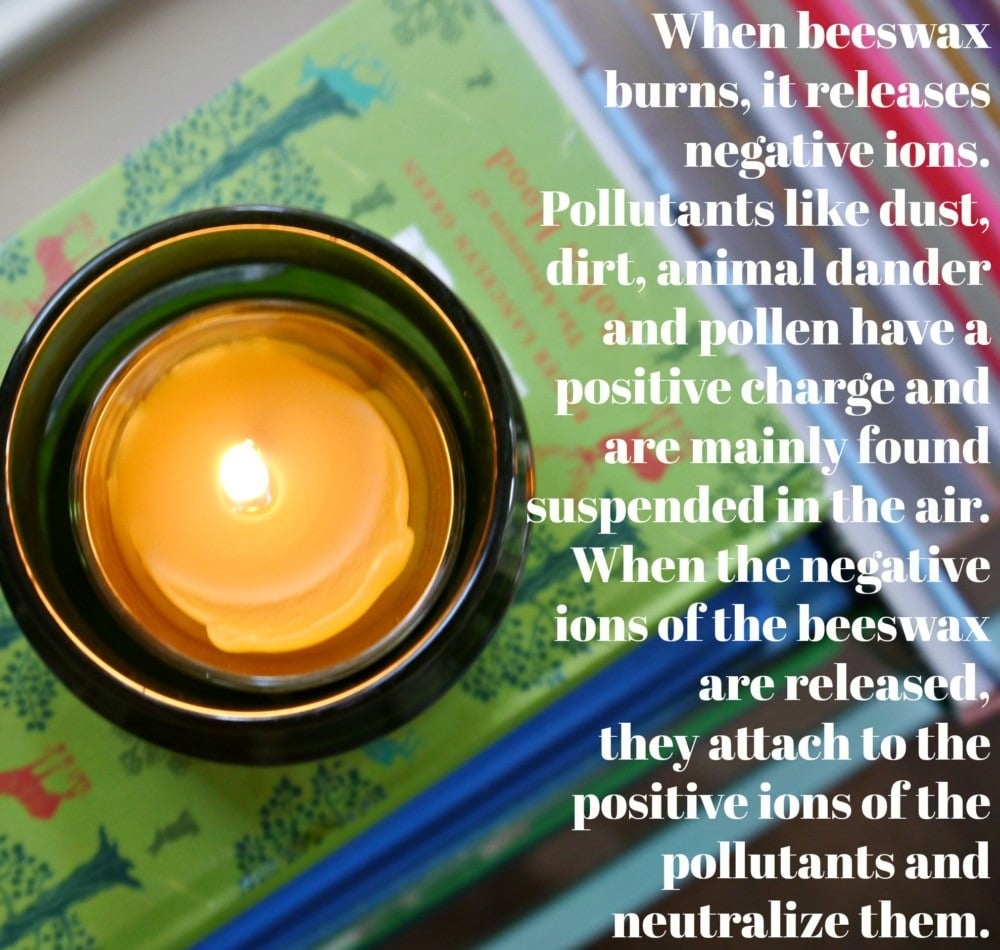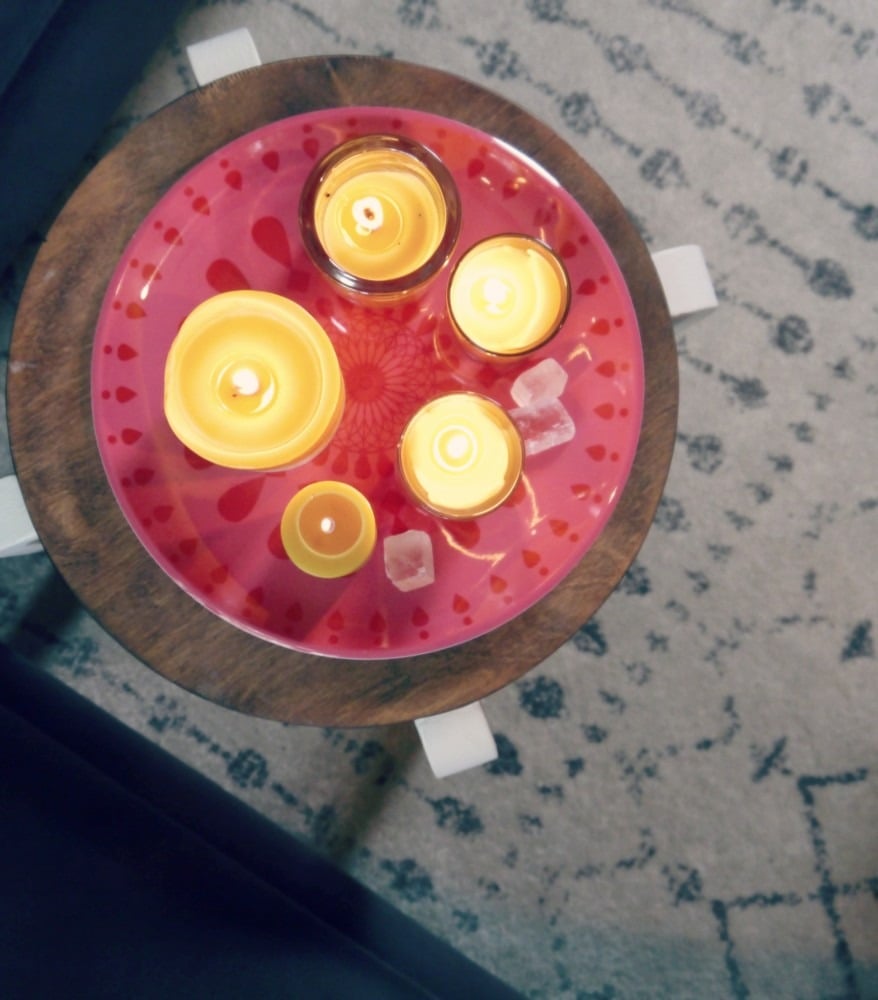The benefits of burning beeswax candles are vast and I’m betting you’ll be surprised by most of them! If you enjoy a candle burning in your home but have heard of the dangers of traditional candles, you’ll be excited to learn that natural beeswax candles can improve your air quality, burn longer and emit less smoke and soot. And these are just a few of the reasons you’ll want to burn beeswax candles after reading this post!

Most of us are familiar with using beeswax in our skin care recipes. Beeswax is a natural substance made by bees that actually thickens oils. Balms and Salves are made by heating oils and beeswax. Once the mixture cools, you have a solid balm. I wrote an in-depth post on all the amazing and exciting skin benefits of beeswax.
Beeswax also can be made into candles. Very healthy candles with unique benefits I should add. Let’s find out why!
What is Beeswax?
How beeswax is made is a complicated question but in very basic terms, beeswax is an excretion of the young female honeybee after she eats honey. It’s purpose is to form the structure of the hive where honey and bee eggs are stored. Female honey bees have 8 glands in their stomachs to produce beeswax and excrete it through a special wax gland on their stomach. It’s excreted as liquid but hardens once it is out of the bee’s body. The worker bees come and mold the beeswax into honeycombs with their jaws.
Interestingly enough, beeswax is only produced by the bees during the months of April through June.
Why Burn Beeswax Candles over Other Candles?
Good quality beeswax candles are free of artificial dyes, harmful chemicals and other air pollutants. Burning a beeswax candle can actually result in cleaner air for your home. Many other types of candles that do not contain all natural ingredients such as paraffin and soy wax candles actually degrade the air quality and cause respiratory issues. Below are 2 scientific studies backing up this information.
A 2014 study concluded that the normal use of candles does not pose a threat to the health of the consumer. It showed that even though toxic chemicals like formaldehyde and benzene were emitted by burning candles, the amount was still under the recommended limit set by the World Health Organization. Come to find out, that study was carried out by scientist that had affiliations with candle manufacturers such as SCI Johnson & Son and Procter and Gamble.
A 2015 Korean study concluded that burning candles emitted VOC (volatile organic compounds) whether lit or unlit and “should act as potent sources of VOC emission in indoor environments.” VOC exposure can cause headaches, migraines, irritation to the eyes, nose and throat as well as causing damage to the nervous system, kidneys and liver.
Related Post: DIY Beeswax Lip Balm (Burt’s Bees Dupe)

What’s the Problem With Paraffin Candles?
There are several different types of candles. The most popular type of candles are paraffin candles. They are popular for good reason-they are cheap and easily found at any drug store. Paraffin is a petroleum by-product from the processes used to refine crude oil into fuels like gasoline. The by-product is actually a black sludge that needs to be bleached with a substance that is 10x more concentrated than household bleach.
Paraffin wax also contains a bevy of unpronounceable toxic chemicals as well as possible toxic metal wicks and artificial fragrances that containing parabens, phthalates and sulfates.
According to the EPA (Environmental Protection Agency), paraffin wax candles are the leading cause of indoor air pollution.
When toxic candles are burned, they release volatile organic, toxic compounds like lead, formaldehyde, naphthalene and phthalates. Between the paraffin and fragrances, carcinogenic soot is released and can be trouble for the respiratory system, especially for those suffering from asthma. Including pets!
Phthalates are released into the air when burning candles and have been known to cause hormone issues that can lead to diabetes, birth defects and cancer.
What’s the Problem With Soy Candles?
While soy candles are a better choice than paraffin candles, soy wax has plenty of issues of it’s own. First off, soy is not a natural wax. It is a heavy metal hydrogenated oil. Plus 96% of soy beans grown around the world are genetically modified by Monsanto. There is also a huge amount of chemicals and pesticides being used on soybean crops.
Related Post: DIY Lotion Bars

Benefits of Beeswax Candles:
- The main benefit of beeswax candles is improving indoor air quality. When beeswax burns, it releases negative ions. Pollutants like dust, dirt, animal dander and pollen have a positive charge and are mainly found suspended in the air. When the negative ions of the beeswax are released, they attach to the positive ions of the pollutants and neutralizes them. Once the dirt, pollen etc. is neutralized, they are no longer an issue and typically fall to the ground therefore, leaving the air cleansed. Because beeswax candles reduce indoor pollutants, they can often have a very positive effect on allergy sufferers and even relieve asthma symptoms!
- Beeswax candles are fragrance free and have their own natural scent. While there is a natural honey scent of beeswax candles, there is no artificial fragrance added.
- Beeswax candles burn slower than most candles because they are more dense. In fact, they last 30-40% longer burn time than regular candles!
- Less soot due to the high melting point is another amazing benefit of burning beeswax candles. Beeswax candles are definitely a cleaner burning option.
- Beeswax candles are vegetarian lifestyle friendly because beeswax is not a derivative of animal fat.
- A warm glow reminiscent of natural sunlight is given off when burning a beeswax candle. They can reduce eye strain and their light is soothing to the eyes.
- Due to the higher melting point, beeswax candles are less likely to melt and drip.
- The environmental benefits of beeswax candles are that they are biodegradable and a renewable resource.
- Beeswax doesn’t have a shelf life so your candles will last forever!
Related Post: DIY Beeswax Citronella Candles

DIY or BUY Beeswax Candles?
I have made my own beeswax candles. I found that in order to make pure beeswax candles with quality beeswax, it was expensive. Also, I found it very tricky to prevent tunneling. However, it is an enjoyable project to make your own beeswax candles and I wrote an article detailing exactly how to do it. Even though I have not perfected the art of candle making, I still love to make beeswax candles regularly.
Buying beeswax candles is definitely the easier option. As with everything, your source is vital because there are many candle companies offering beeswax candles that only contain about 50% beeswax.
I get my beeswax candles from Mountain Rose Herbs. Their candles are free from synthetic fragrances, paraffin, and petroleum by-products. I have also bought high-quality candles from the sisters at Quiet Light Candles. Supporting local beekeepers is the best source of candles though since ingesting local honey as well as burning local beeswax can reduce seasonal allergies!
I encourage you to jump into burning beeswax candles. There have been many people claim that by burning beeswax candles, their allergies were eliminated as well as a great relief with asthma! In fact, I’m using beeswax candles in my oldest daughter’s room to help with her coughing and breathing issues. Believe it or not we’ve had to resort to an inhaler but she’s seeing improvement and using it way less! I also have a good friend who comes over almost weekly who is allergic to cats. I always burn beeswax candles about 2 hours before she comes and so far she’s not had an attack!
If you are looking for more natural ways to “clear the air”, diffusing is a great way to purify the air as well as making a SAFE yet effective room spray recipe!
xx, Jenni
PIN IT!!!

Wow! What an excellent alternative to some high technology air purifiers. Thanks for sharing!
Hi Jenni,
Just read your post on air detox with beeswax candles – what an eye-opener! Thanks for shedding light on this and inspiring me to make healthier choices for my home. Looking forward to more insights from you!